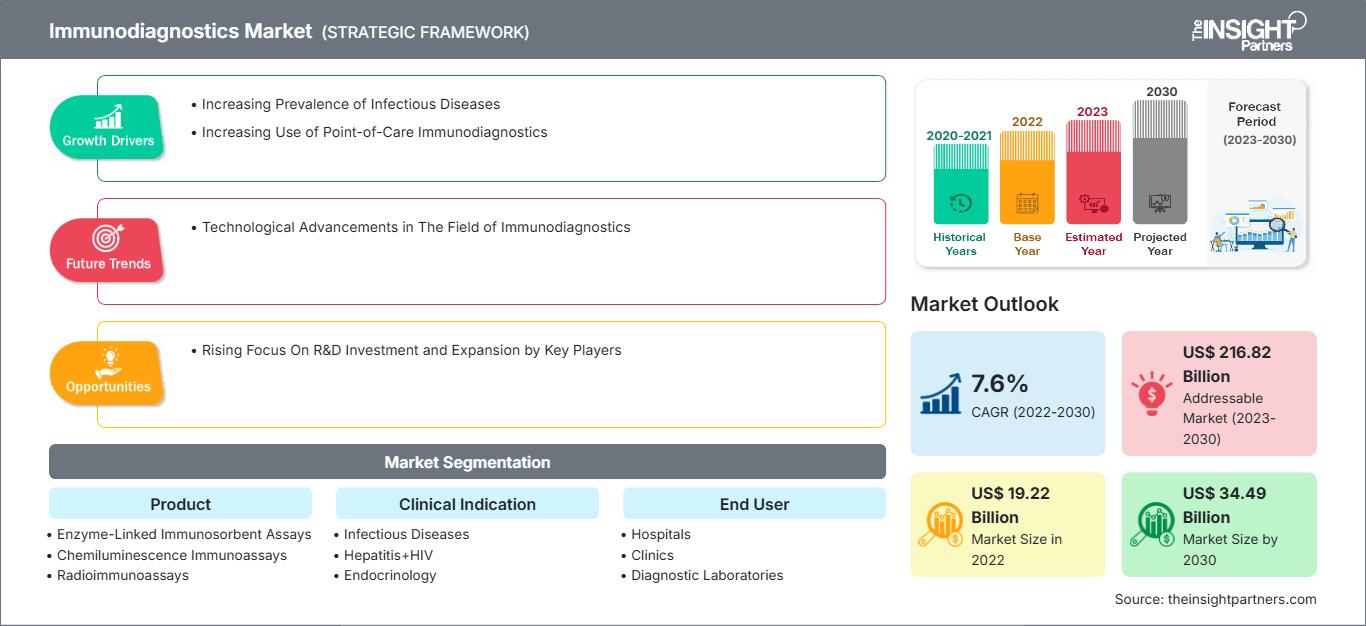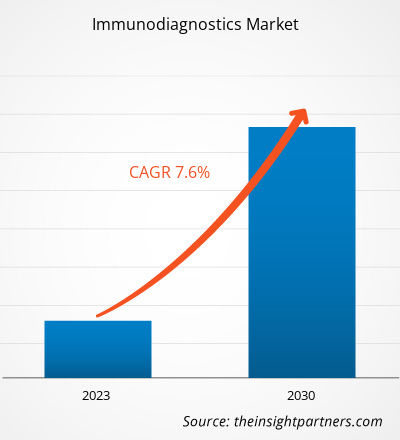[研究报告] 预计到 2030 年,免疫诊断市场规模将从 2022 年的 192.1889 亿美元增长至 344.878 亿美元;预计 2022 年至 2030 年免疫诊断市场的复合年增长率为 7.6%。
分析师观点:
由于诊断领域的显著发展,免疫诊断市场预计将蓬勃发展。在 COVID-19 疫情期间,免疫诊断市场的增长得到了推动。多家公司获得了产品的紧急授权,这有助于它们将产品商业化推向市场。此外,市场的增长主要归因于对快速诊断技术研发投入的增加。各公司做出了各种战略决策,以扩大其产品组合和地域覆盖范围。此外,预期寿命的提高导致老年人口显著增加,从而增加了对免疫诊断的需求。此外,人们意识的提高和健康标准的改变也增加了对早期诊断的需求,这推动了对各种诊断设备的需求。此外,对免疫诊断的发展及其益处的认识也增加了免疫诊断技术的使用。
市场概览:
免疫诊断是一种主要使用抗原抗体反应作为主要检测手段的诊断方法。针对目标抗原的特异性抗体可以与放射性标记、荧光标记或显色酶结合,并用作探针进行检测。此类测试的速度、准确性和简便性促进了用于在体内快速诊断疾病、微生物甚至非法药物的技术的发展。推动传染病发病率上升和即时诊断应用日益普及的关键因素推动了免疫诊断市场的增长。然而,报销不足阻碍了市场的增长。从地域上看,北美是最大的市场,其次是欧洲。在北美,美国占据了免疫诊断市场的最大份额。亚太地区是全球免疫诊断市场增长最快的地区。在亚太地区,中国是最大的免疫诊断市场,预计在预测期内仍将保持主导地位。
自定义此报告以满足您的要求
您将免费获得任何报告的定制,包括本报告的部分内容,或国家级分析、Excel 数据包,以及为初创企业和大学提供超值优惠和折扣
免疫诊断市场: 战略洞察

- 获取本报告的主要市场趋势。这个免费样本将包括数据分析,从市场趋势到估计和预测。
您将免费获得任何报告的定制,包括本报告的部分内容,或国家级分析、Excel 数据包,以及为初创企业和大学提供超值优惠和折扣
免疫诊断市场: 战略洞察

- 获取本报告的主要市场趋势。这个免费样本将包括数据分析,从市场趋势到估计和预测。
市场驱动因素:
传染病患病率不断上升
由病毒、真菌、细菌、寄生虫或其毒性产物等传染源引起的几种日益增多的传染病的诊断和管理,导致免疫诊断检测(例如补体结合试验、沉淀试验、凝集试验、线印迹试验、蛋白质印迹试验、酶联免疫吸附试验 (EIA) 和免疫荧光试验)的处方数量激增。
人类免疫缺陷病毒 (HIV) 仍然是全球主要的公共卫生问题。根据联合国艾滋病规划署 (UNAIDS) 的数据,2021 年全球约有 3840 万人感染艾滋病毒。此外,肝炎是推动免疫诊断市场发展的另一个主要因素。据世界卫生组织 (WHO) 统计,全球近 5800 万人患有慢性丙型肝炎,每年新增病例 150 万例。此外,约有 320 万青少年和儿童感染丙型肝炎。经所有成员国批准的世卫组织全球肝炎战略旨在在 2016 年至 2030 年期间将肝炎新发感染减少 90%,死亡率减少 65%。这些全球举措正在推动对免疫诊断产品的需求。
此外,结核病 (TB)、COVID-19 和其他医院获得性感染 (HAI) 都需要进行免疫诊断检测。
- 结核病已成为全球第 13 大死亡原因,也是继 COVID-19 之后第二大传染病杀手。 2020年,全球有150万人死于结核病,估计受影响人数达1000万,其中包括560万男性、330万女性和110万儿童。
- 2021年,美国50个州和哥伦比亚特区(DC)共向美国疾病控制与预防中心(CDC)的国家结核病监测系统(NTSS)报告了7860例结核病病例。
- 据Worldometer数据,全球因COVID-19疫情死亡人数达数百万。疫情给医疗系统带来了巨大压力,并增加了对免疫诊断检测的需求。
诊断在确定合适的治疗方法方面发挥着至关重要的作用。免疫诊断有助于诊断严重影响免疫系统的疾病。因此,传染病的流行率上升导致对免疫诊断产品的需求激增。
细分分析:
全球免疫诊断市场细分为产品、临床适应症和最终用户。基于产品,市场细分为酶联免疫吸附试验 (ELISA)、化学发光免疫测定 (CLIA)、放射免疫测定 (RIA) 和其他。按产品划分,酶联免疫吸附试验 (ELISA) 细分市场占有最大的市场份额。传染病是由细菌、病毒、寄生虫和真菌等有害病原体进入人体引起的。它们通常通过受污染的食物或水以及虫咬传播。传染病占据了免疫诊断市场的很大一部分。免疫诊断测试是为了补充传染病研究中分子检测的结果而进行的。多种免疫诊断测试用于诊断传染病、检测内分泌和肿瘤疾病以及测量血液药物浓度。基于酶的免疫测定法利用抗体检测抗原并定量抗体。蛋白质印迹法则基于抗体与通过印迹固定在膜上的靶抗原(病毒成分)之间的反应,检测患者血清或不同体液样本中的抗体。
预计化学发光免疫测定 (CLIA) 细分市场在预测期内将录得最高复合年增长率。CLIA 细分市场进一步细分为维生素 D 检测、HIV 检测、HIV AG/AB 组合检测等。
根据临床适应症,市场细分为传染病、肝炎 + HIV、内分泌学、胃肠道、代谢和其他。传染病在 2022 年获得了最高的市场价值,预计在预测期内也将录得最高的复合年增长率。传染病细分市场进一步细分为新冠肺炎 (COVID-19)、结核病、莱姆病、感染管理、寨卡病毒、梅毒螺旋体、TORCH、麻疹和腮腺炎、水痘带状疱疹病毒 (VZV) 和 EBV。同样,内分泌学细分市场进一步细分为高血压、生长发育、糖尿病、甲状腺和生殖内分泌。
根据最终用户,免疫诊断市场分为医院、诊所、诊断实验室、学术和研究机构以及其他。医院细分市场在 2022 年占据了最大的市场份额。预计诊所细分市场在预测期内的复合年增长率最高。
区域分析:
北美占据全球免疫诊断市场的最大份额,2022 年市场价值为 97.728 亿美元,复合年增长率为 7.5%。北美是最大的免疫诊断市场,其中美国、加拿大和墨西哥是该地区市场的主要贡献者。政府对采用先进诊断技术的支持日益增多、研发投入不断加大以及市场参与者采取战略合作等举措,都推动了免疫诊断市场的显著增长。此外,诊断行业参与者的技术进步很可能成为未来几年北美免疫诊断市场的主要增长动力。与此同时,亚太地区是全球免疫诊断市场增长最快的地区。美国是最大的市场,免疫诊断市场的增长动力源于日益增长的癌症发病率(需要诊断)以及免疫诊断领域的不断发展。亚太免疫诊断市场分为中国、印度、日本、韩国、澳大利亚和亚太地区其他地区。亚太地区慢性病发病率的不断上升,导致对诊断检测的需求激增,这些检测能够提供与疾病相关的检测、诊断和治疗等医疗保健关键信息。此外,国内企业在免疫诊断产品和技术开发方面的投入,有望在预测期内推动免疫诊断市场的增长。
免疫诊断市场区域洞察
The Insight Partners 的分析师已详尽阐述了预测期内影响免疫诊断市场的区域趋势和因素。本节还讨论了北美、欧洲、亚太地区、中东和非洲以及南美和中美洲的免疫诊断市场细分和地域分布。
免疫诊断市场报告范围
| 报告属性 | 细节 |
|---|---|
| 市场规模 2022 | US$ 19.22 Billion |
| 市场规模 2030 | US$ 34.49 Billion |
| 全球复合年增长率 (2022 - 2030) | 7.6% |
| 历史数据 | 2020-2021 |
| 预测期 | 2023-2030 |
| 涵盖的领域 |
By 产品
|
| 覆盖地区和国家 | 北美
|
| 市场领导者和主要公司简介 |
|
免疫诊断市场参与者密度:了解其对业务动态的影响
免疫诊断市场正在快速增长,这得益于终端用户需求的不断增长,而这些需求的驱动因素包括消费者偏好的演变、技术进步以及对产品优势的认知度的提升。随着需求的增长,企业正在扩展产品线,不断创新以满足消费者需求,并抓住新兴趋势,从而进一步推动市场增长。

- 获取 免疫诊断市场 主要参与者概述
关键参与者分析:
免疫诊断市场主要由雅培实验室 (Abbott Laboratories)、罗氏公司 (F. Hoffmann-La Roche Ltd)、DiaSorin SpA、丹纳赫公司 (Danaher Corp)、赛默飞世尔科技公司 (Thermo Fisher Scientific Inc)、珀金埃尔默公司 (PerkinElmer Inc)、深圳迈瑞生物医疗电子股份有限公司 (Shenzhen Mindray Bio-Medical Electronics Co Ltd)、bioMerieux SA、Svar Life Science AB 和西门子医疗股份公司 (Siemens Healthineers AG) 等参与者组成。
雅培实验室 (Abbott Laboratories) 和罗氏公司 (F. Hoffmann-La Roche Ltd) 是免疫诊断市场的两大参与者。这些公司一直在实施各种战略,这些战略促进了公司的发展,进而带来了市场的各种变化。这些公司采用了产品发布、扩张和产品审批等有机策略。另一方面,产品发布、合作伙伴关系和协作等无机策略在免疫诊断市场中广泛存在。
最新动态:
免疫诊断市场中的公司广泛采用无机和有机策略。以下列出了一些近期的关键市场动态:
- 2023 年 4 月,赛默飞世尔科技宣布与全球领先的诊断公司 ALPCO-GeneProof 建立合作伙伴关系。此次合作有助于将 TaqPath Menu | GeneProof PCR 试剂盒推向市场。
- 2022年7月,雅培诊断宣布将参加2022年美国临床化学协会(AACC)。在此次展会上,该公司展示了其诊断系统和分析仪。
- 2023年5月,赛默飞世尔科技宣布其免疫测定产品B·R·A·H·M·S PlGF plus KRYPTOR和B·R·A·H·M·S sFlt-1 KRYPTOR新型生物标志物已获得美国食品药品监督管理局(FDA)的批准。这些免疫测定产品用于评估先兆子痫(一种严重的妊娠并发症)的风险和临床管理。
- 历史分析(2 年)、基准年、预测(7 年)及复合年增长率
- PEST和SWOT分析
- 市场规模、价值/数量 - 全球、区域、国家
- 行业和竞争格局
- Excel 数据集
近期报告
客户评价
购买理由
- 明智的决策
- 了解市场动态
- 竞争分析
- 客户洞察
- 市场预测
- 风险规避
- 战略规划
- 投资论证
- 识别新兴市场
- 优化营销策略
- 提升运营效率
- 顺应监管趋势




















 获取免费样品 - 免疫诊断市场
获取免费样品 - 免疫诊断市场